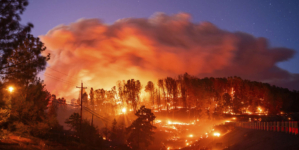-
Meghan Markle steps up Hollywood networking with Kimberly Williams-Paisley lunch, reported Hamptons trip - 6 mins ago
-
Rangers vs. Blue Jays Highlights | MLB on FOX - 18 mins ago
-
Harvey Weinstein’s Medical Condition Takes Massive Turn - 39 mins ago
-
Dodgers’ Freddie Freeman scratched, returning to Los Angeles to be with family - about 1 hour ago
-
Missing Tanker Plane Fighting Oregon Wildfire Found, Pilot Dead - about 1 hour ago
-
Reds vs. Rays Highlights | MLB on FOX - 2 hours ago
-
F1 News: Red Bull Hit With Unexpected Fines at Belgian Grand Prix - 2 hours ago
-
Interview with Rheinmetall Hungary CEO, Paul Walf - 2 hours ago
-
Athletics vs. Angels Highlights | MLB on FOX - 2 hours ago
-
Harrison Butker’s Comments on Olympics Opening Ceremony Goes Viral - 3 hours ago
Ongoing Brazil floods raise specter of climate migration
Southern Brazil’s location at the confluence of tropical and polar currents has fed periods of increasingly intense drought and rains due to climate change, according to scientists.
The record devastation in Rio Grande do Sul follows floods in the second half of last year, leading many of the 538,000 people now displaced from their homes to consider more extreme adaptations.
For the third time in seven months, businessman Cassiano Baldasso had to remove wheelbarrows of mud from his home in Muçum, a small town 150 km (90 miles) upriver from Porto Alegre, only to see the waters rise again. He says he has had enough.
“I have no idea where I’m going, but it will be somewhere far from the river, where our lives will not be at risk,” Baldasso told Reuters as he removed another cart of mud from inside the house.
Mayor Mateus Trojan said many of Muçum’s 5,000 residents will have to relocate. His office is planning to rebuild 40% of the town elsewhere.
Baldasso had already saved his family in September by climbing onto the roof of their two-story house until they were rescued by the fire brigade in the middle of the night.
During that flood, just a few blocks away, Maria Marlene Venancio’s house was swept away and she lost everything. This month, the rented house she had moved to was flooded 1.5 meters (5 ft) deep. She fears it is time to leave Muçum.
“I think the town will become a river one day, and it will be difficult for us to live here. People with money are all leaving,” she said.
Governor Eduardo Leite has said initial calculations show Rio Grande do Sul will need at least 19 billion reais ($3.7 billion) to rebuild from the disaster. The federal government has offered to freeze 11 billion reais of debt payments for three years.

On the streets of Muçum and other nearby towns, the slowly receding waters leave desolate scenes of furniture, clothing and appliances piled up in front of the houses.
Maria Ines Silverio has returned to her house, but she keeps her clothes in plastic bags for fear of the river rising again. She has a 30-year mortgage and says she cannot afford to leave.
“When we bought the house, this wasn’t a flooded area. Now it is, and the river is going to rise more and more,” she said.
Environmental experts warn that there is no alternative for some towns in the state but to relocate entire neighborhoods.
“We need to move urban infrastructure away from high-risk environments and return space to the rivers … so they no longer impact cities with such magnitude,” said ecologist Marcelo Dutra, professor at the Rio Grande Federal University.
“We can’t oppose nature. We have to wake up to this force that is telling us we need to adapt and respect nature,” he said.
Source link































